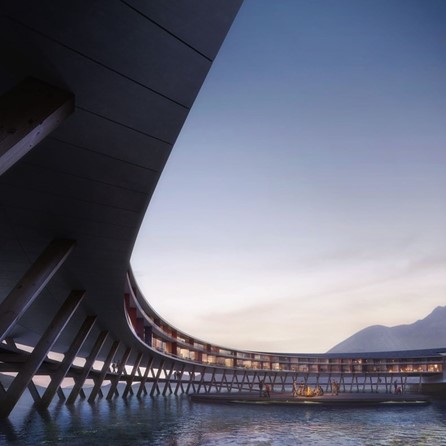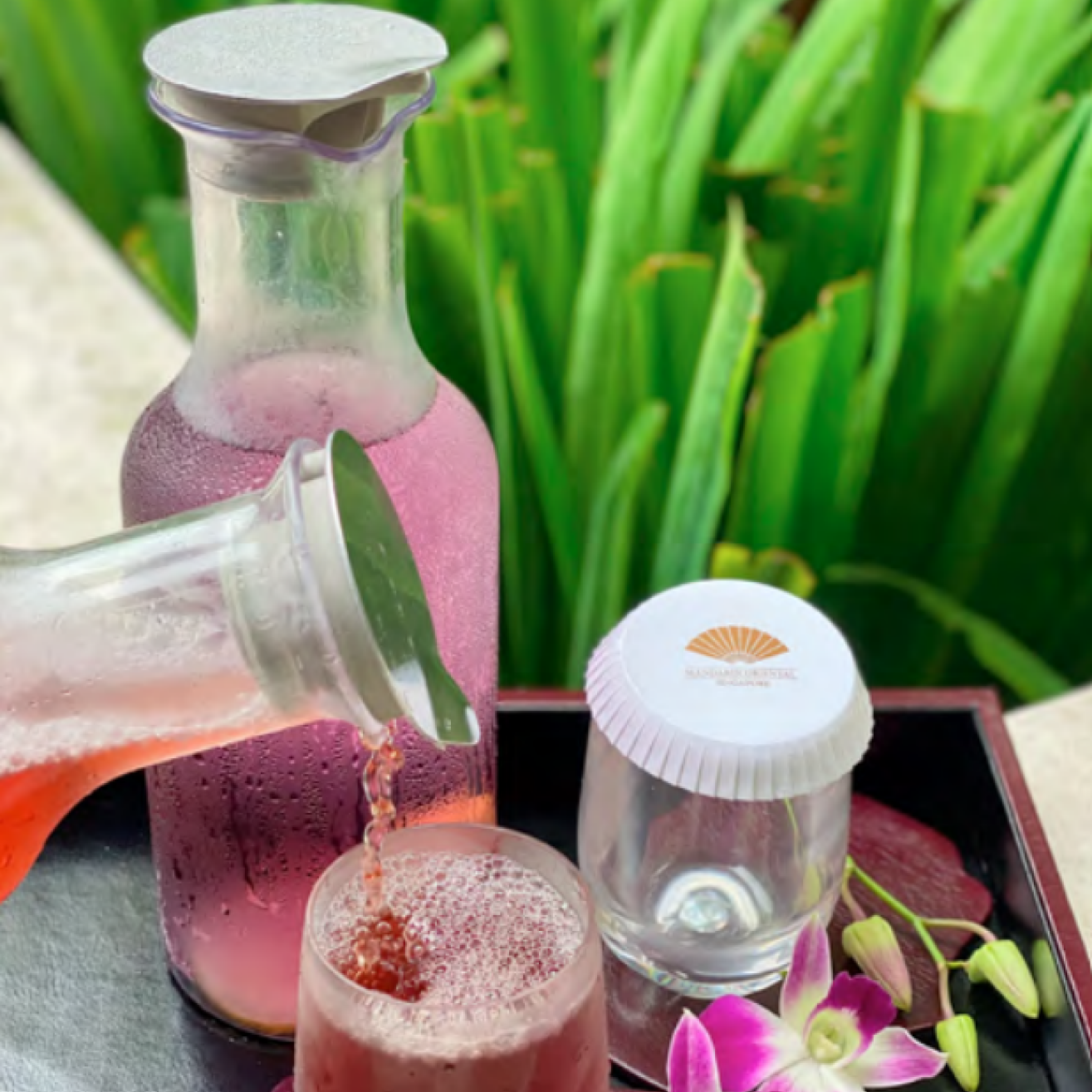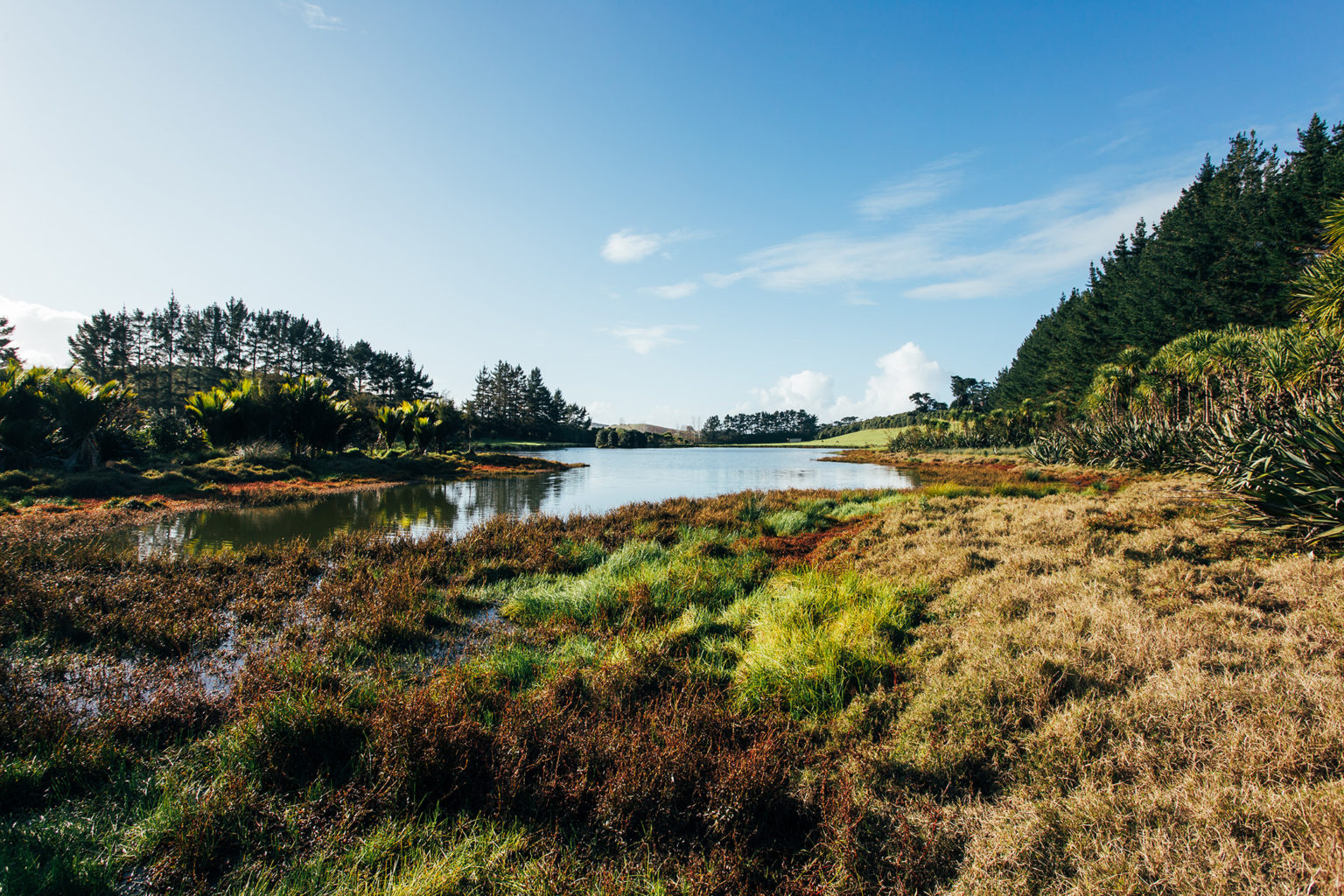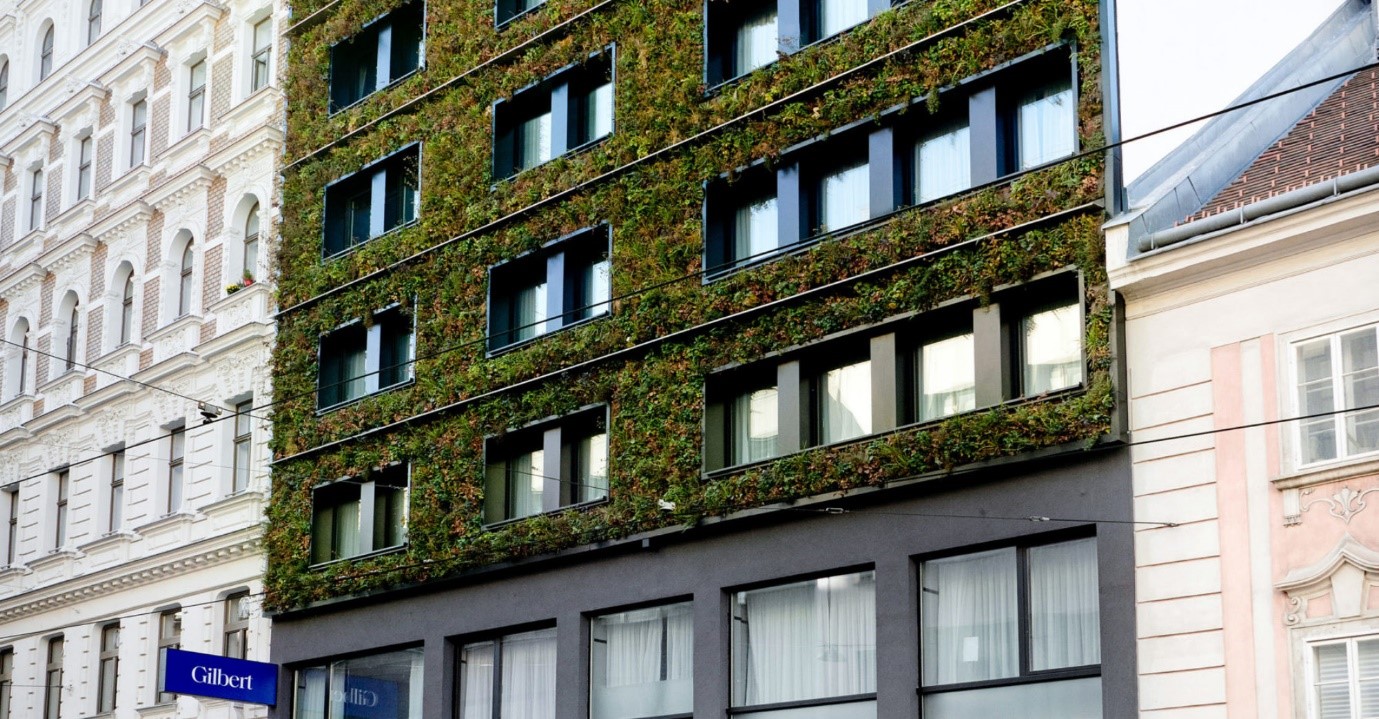Showcasing hospitality properties
and their pioneering eco-friendly practices
Adam Maclennan
Managing Director
Consulting
PKF hospitality group
Aneliya Antova
Research Assistant
PKF hospitality group
May 2023
Climate change, freshwater depletion, unsustainable use of resources, and biodiversity collapse are some of the most pressing challenges faced by humanity today. As the world’s population increases, so does the pressure on the world’s natural resources and on local communities. While hospitality might on the surface be less damaging than other industries where pollution is more visible (manufacturing, transport, agriculture, etc.), the hospitality service sector and its supply chain are directly affecting and being affected by sustainability matters. Energy and water consumption, working conditions, employment, waste, and carbon emission are among the issues which need to be urgently addressed by our industry. This article showcases real life examples of hotel businesses that are taking steps to contribute towards achieving the United Nations Sustainable Development Goals and meeting the targets by the Paris Agreement. Businesses and governments need to take action to meet the challenges we all face. We have highlighted seven hotels below where owners and operators are taking these challenges seriously and are finding ways for their businesses to be part of a solution which embraces hospitality and nature.
Greenhouse gas emissions
According to research conducted by the United Nations World Tourism Organisation (UNWTO) the carbon emissions emitted by the tourism industry are forecast to increase by 25 % in 2025 compared to the CO2 level in 2016. Furthermore, it is estimated that there could be 1.8 billion travellers by 2030 which as Mr. Taleb Rifai, the former Secretary-General of UNWTO, points out, “could be 1.8 billion opportunities or 1.8 billion disasters”. In 2020, during the Covid-19 pandemic, when most flights and tourism destinations were shut down, the tourism industry decreased greenhouse gas emissions by around 7 %, which coincidentally is the percentage decline that is needed every year in order to keep to the science-based targets. This stark reality provides a tangible reference about the magnitude of efforts needed for the tourism industry to play a role in confronting climate change.
The resilience of the sector depends on its ability to cut emissions in half by 2030, to accelerate climate action, and to embrace a genuine low carbon pathway. To facilitate and guide this transition process, in 2021 the UN launched the Glasgow Declaration, which sets a framework for climate-related planning, measuring, and reporting standards. Global warming can be mitigated in the hospitality industry in various ways: energy and water efficiency, waste reduction, sustainable use of resources, green building practices, and others. The following examples showcase two properties and their eco-friendly initiatives aligned with global climate goals.
• Carbon neutral and emission-free resort
The first property presented in this article sets high standards for new hospitality buildings. The hotel Svart in Norway will open in 2024 under the brand Six Senses and will be “the first fully carbon-neutral and emission-free resort”. The property uses 85 % less energy than other comparable hotels and through eco-friendly energy sources (solar panels and geothermal wells) it will generate more power than is necessary for operations and that was used during the construction phase. It is expected that within five years of opening, the property will be fully off-grid and self-sufficient in electricity, water, and waste management. The circular design of the building optimizes sunlight for solar energy production and for maximum daylight. Furthermore, the carbon footprint of the building is being minimized by reducing the use of energy-intensive building materials (for example, concrete and structural steel) and the property itself is on a secure wooden structure in order to avoid land impact and prevent disruptions of the seabed. Given the remote location of the hotel and the lack of infrastructure, the property will be reached only by the hotel’s two electric boats to preserve the virgin landscape of the region. As the development director of Svart hotel, Ivaylo Lefterov, said: “If we can do it in the foothill of a glacier then we can do it
anywhere.” To educate stakeholders on sustainable hospitality practices, the property will promote two programmes on and off-site: the Earth Lab, focused on “lifecycle living” initiatives, and the Svart Design Lab, showcasing innovative technologies, connected to carbon neutrality and cradle-to-cradle hospitality services.
• Zero energy balance
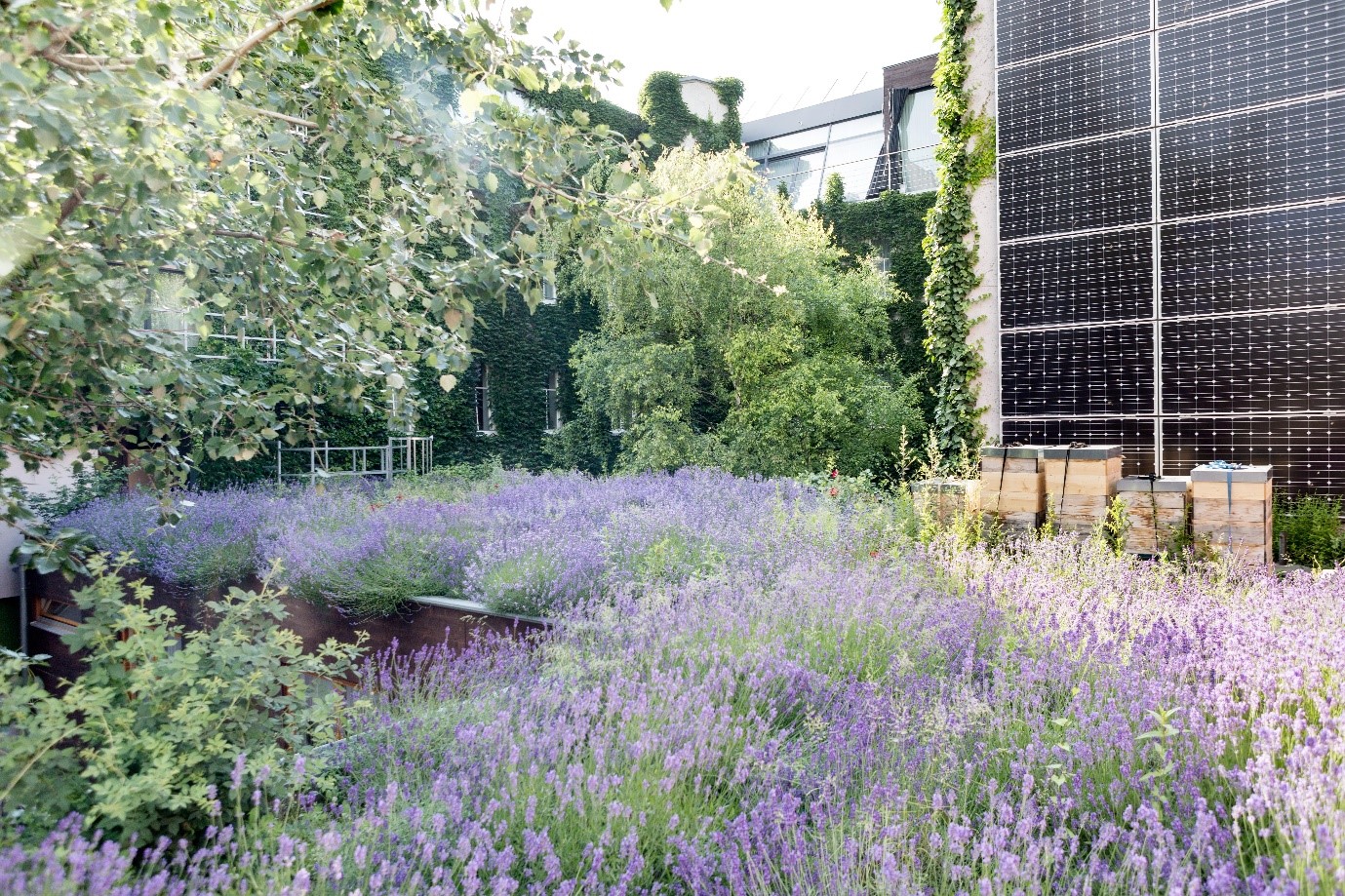
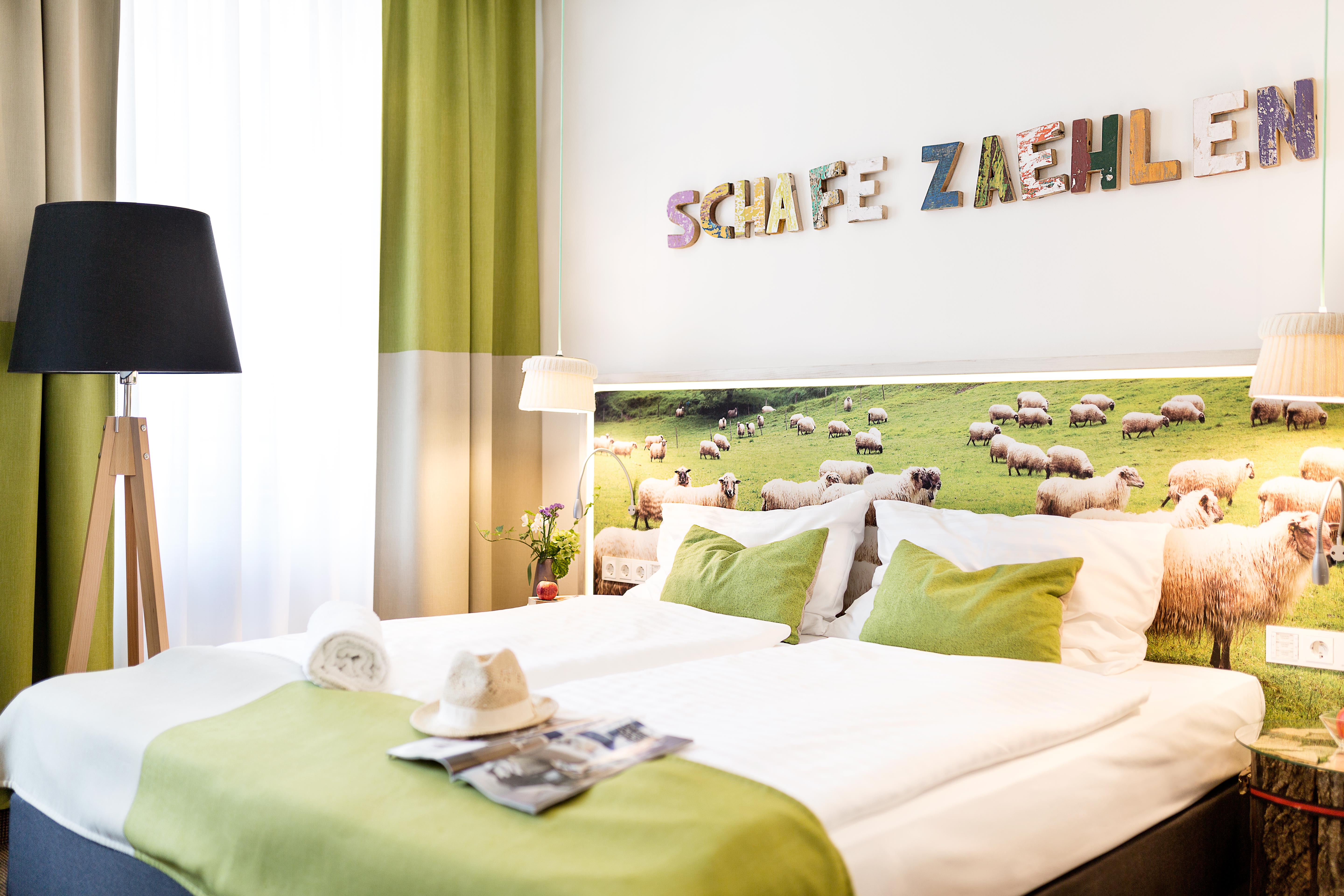
Hotel (© Boutiquehotel Stadthalle/ Tina Herzl)
Website link
While the above example showcases an off-grid property, sustainable operations can be achieved in an urban area as well. Such is the case of Boutiquehotel Stadthalle in the city centre of Vienna. The hotel is zero-energy balance property which means that within a year it generates the same amount of energy as it consumes. The needed energy is generated via a groundwater heat pump, 93 sq. m. photovoltaic technology, and 130 sq. m. solar power plant. In 2008, the hotel was extended through a second building with 38 guest rooms. The building was constructed following the passive house standards and achieved the goal of zero-energy balance. Passive houses are low-energy buildings which use energy sources inside the building (groundwater heating pump, solar energy, wind energy, etc.), have very good insulation of windows, walls, roof, and floor, and a highly energy efficient ventilation system. In the case of Boutiquehotel Stadthalle, the fresh air for the controlled ventilation system is heated through solar power and in summer cooled by the cold groundwater pumped through the concrete ceiling. Other practices that improve energy efficiency in the hotel include the use of LED lightbulbs and eco-shower heads, 100 % waste separation, and the decision to not use highly energy consuming appliances such as minibars.
Waste management
A recent report by the United States National Academy of Sciences estimated that around 8.8 million metric tons of plastic waste end up in the ocean every year, which, to put into perspective, would mean that every minute a garbage truck of plastic is dumped into the sea. Overall, global waste was estimated to be 2.01 million tonnes in 2016 with trend to increase to 3.4 billion tonnes by 2050. Images of the Great Pacific Garbage Patch, pristine beaches covered in waste, burning landfills, and animals suffocating due to plastic are just some of the reasons that call for action to tackle this global problem. It is argued that waste management is also resource management and that any type of waste, be it food waste, plastic packaging, construction materials, etc., is an inefficiency and, hence, a cost.
• Waste management policy
Most of the large hospitality chains such as InterContinental Hotel Group, Accor, Hyatt, Marriott, and others have waste management policies in place to tackle this issue and improve operational efficiency. A comprehensive waste management plan is adopted by the chain Mandarin Oriental Hotel Group. In their 2021 Sustainability Report the group outlines their “Reduce, Reuse, Recycle and Upcycle” strategy aimed at achieving a transition to circular economy. One of their strategies is to cut down paper use as much as possible. Some initiatives include the promotion of online check-in/out, e-folios, e-payslips, e-learning materials, and the use of QR codes for programme information and F&B menus. At present, 87 % of the paper used in all hotel areas is sustainability certified, with an aim to increase the number to 100 %. The hotel chain is also working towards mitigating 99 % of the single use plastic used across all hotel operations. In 2021, the brand achieved among other things a reduction of 7.7 million water bottles, 4.9 million bath amenities bottles, and 1.8 million F&B takeaway items. However, when it comes to plastic waste reduction, there are two main challenges: firstly, guests perceive single-use plastics as a safer option and, secondly, suppliers deliver their products wrapped in plastic packaging as alternatives
are difficult to find. Mandarin Oriental’s efforts are, therefore, aimed at working closely with suppliers to find suitable alternatives to replace single-use plastics and to generally raise awareness about the issue and the need for action across all stakeholders (guests, suppliers, employees).
• Circular economy and upcycling
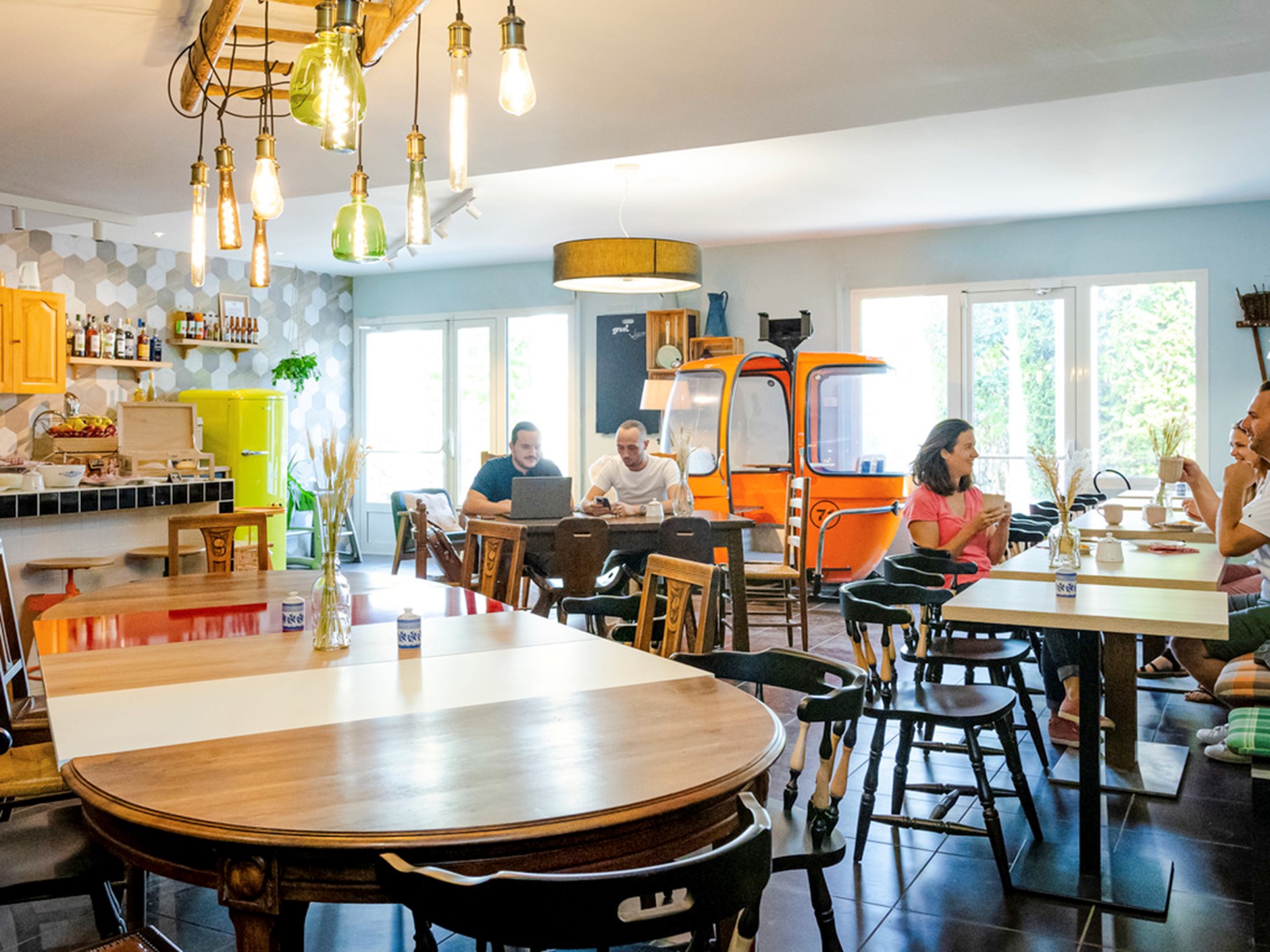
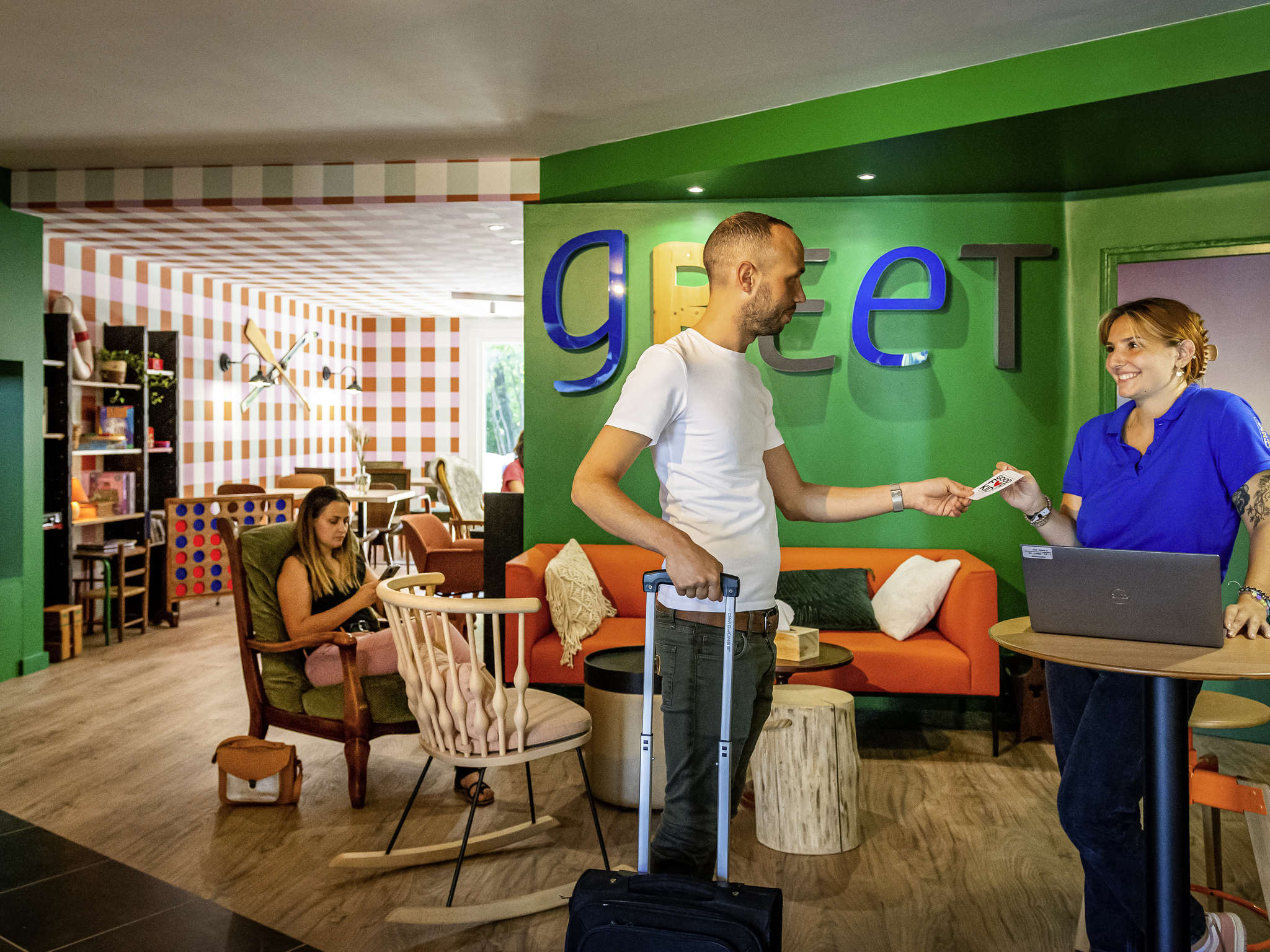
Greet Hotel Annecy Cran Gevrier
Website link
Greet is an economy hotel brand by Accor with 24 open properties, 20 in the pipeline, and 300 planned in total to be opened by 2030. Greet focuses on local engagement and circular hospitality. The principles behind circularity and circular economy are that any type of waste (e-waste, clothes, metals, fibres) is either reused or recycled in order to be returned to the economy. Circularity is at the forefront of the development of the brand and each property is furnished using upcycled materials or second-hand furniture. Furthermore, single-use plastic and products which cannot be recycled are prohibited, contracts are made with local suppliers who use recycled materials and second-hand products, targets are set to minimize energy, water, and food consumption, and all waste is collected, monitored, and recycled. The use of repurposed and second-hand items is essentially the unique selling point of the brand whose approach showcases that giving second life to products is not only attractive for a growing number of travellers, but also a successful business model. Hospitality furniture endures continuous wear and tear with hotels undergoing renovation cycles every five to seven years. The impact of adopting a more circular approach to reusing and renovating furniture, appliances, and construction materials would be significant.
Biodiversity protection
Biological diversity refers to all varieties of genes, species, and ecosystems that can be found on Earth. Nature as we know today is a result of 4.5 billion years of evolution, however, since the start of the Anthropocene in the 1950s (period also known as the Great Acceleration) human activities have resulted in a rapid decline in biodiversity. Rising temperatures are threatening the extinction of millions of species; the Amazon rainforest is turning into a carbon source (rather than a sink) due to deforestation; and 85 % of wetlands – ecosystems vital for biological regeneration and carbon capture have disappeared. Scientists are urgently calling for measures to prevent the so-called “6th mass extinction”. The hospitality industry, despite being a contributor to the problem, has many ways to conserve natural habitats and species while providing alternative sources of income and employment.
• Biodiversity positive
The following paragraphs showcase three properties whose environmental efforts contribute towards different aspects of natural conservation. The first property is Tahi, a carbon neutral and biodiversity positive eco-retreat in New Zealand. The conservation efforts started back in 2004 when the pasture landscape was dominated by six introduced grasses, the plot was not used as a habitat by native animals, and most of the wetlands were in decline. This type of situation is prevalent in developed countries. Today Tahi’s rewilding work has turned the 780-acres of land into a nature sanctuary: bird species have increased from twenty to seventy-one, 430,000 trees have been planted, 141 native species of plants and trees have been recorded, and 95.6 acres of wetlands and 11.1 acres of lakes have been restored. The conservational efforts have resulted in a multiplier effect whereby nature and people work together towards regeneration.
The planted native trees at Tahi have stored more than 2,000 tons of carbon and have contributed towards the creation of a biodiverse natural habitat for birds, insects, and fish species. Furthermore, the preservation and restoration of wetlands has proven to be a great carbon capture. In fact, wetlands can store per hectare as much carbon as native trees and four times more carbon than pine plantations. Wetlands also provide spawning and nursery grounds for fish, purify the water, and provide a refuge for animals in times of drought. The conservational efforts of Tahi have resulted not only in protecting and regenerating the local biodiversity, but also in providing carbon storage to mitigate climate change.
• Coral reef protection
Coral reefs are one of the most diverse habitats on the planet, being home to around 25 % of all marine species. They are called “the rain forests of the seas”. The reefs play a very important role for people and the planet since they, among other things, help maintain fisheries, help protect coastlines from natural disasters, and provide grounds for fish nurseries. Coral reefs are, however, also under imminent threat due to climate change. Scientists predict that if greenhouse gas emissions continue in the business-as-usual manner, all coral reefs will become extinct by the end of this century.
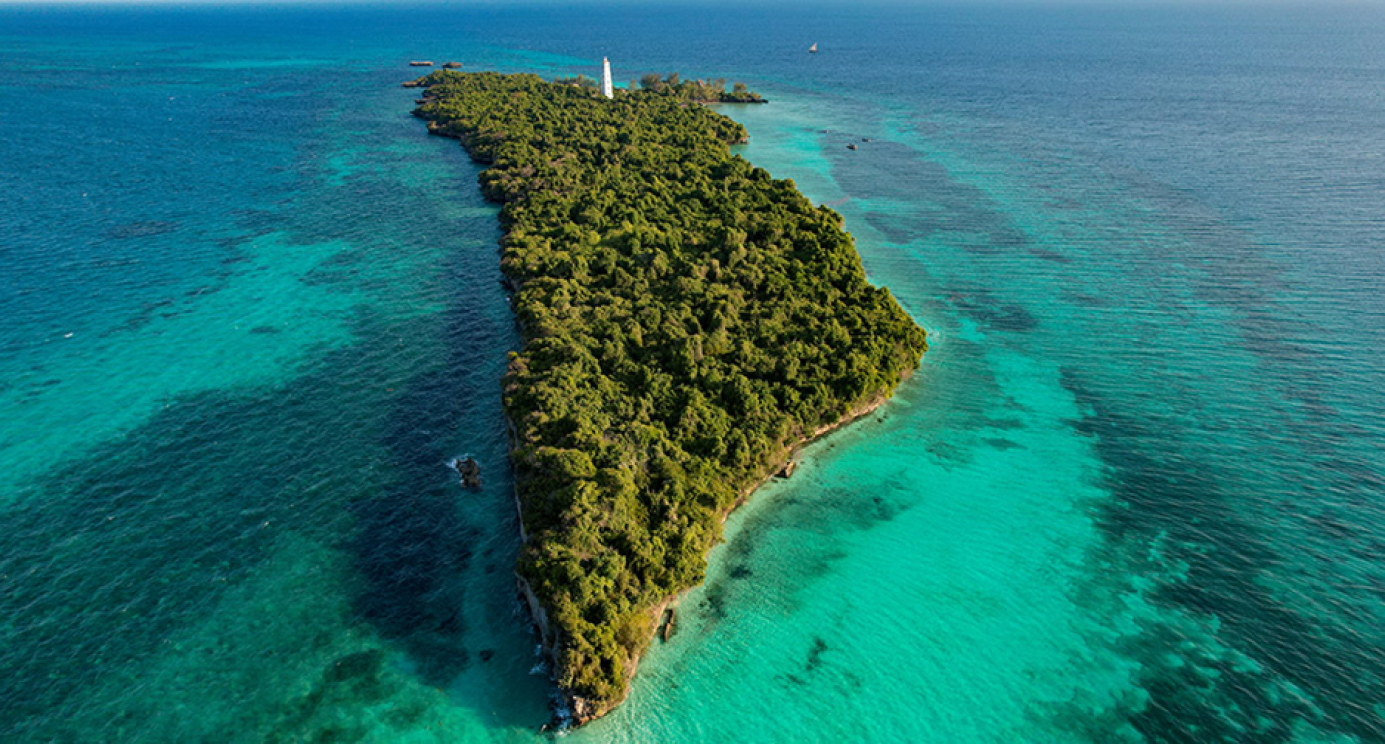
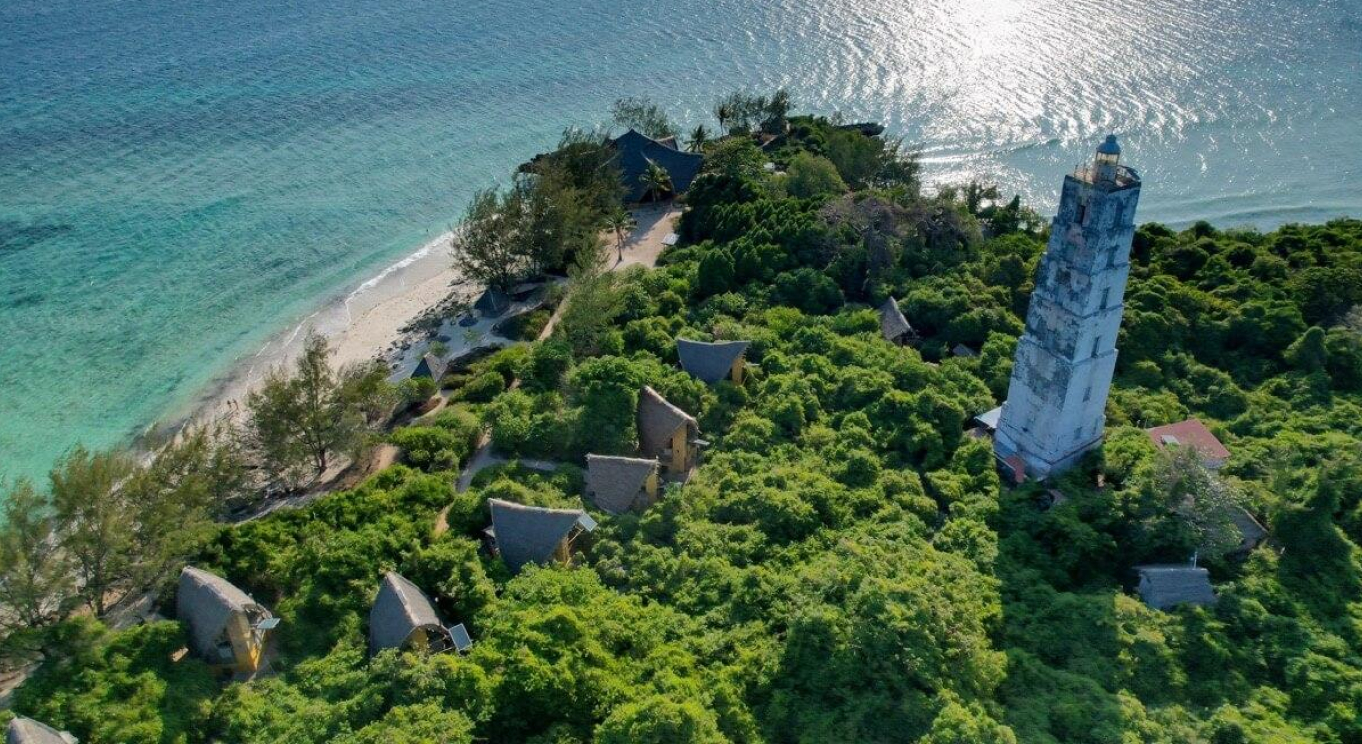
Chumbe Island Coral Park
Website link
A hospitality property which stands out with its coral reef conservation practices is Chumbe Island Coral Park, a private nature reserve in Zanzibar. The resort protects 55 hectares of coral reefs, which is classified as a No-Take-Area, meaning fishing is prohibited. The protected coral reef area hosts more than 400 fish species, 90% of the hard coral species in East Africa, and serves as a feeding ground for hawksbill and green turtles. The protection of this area is not only significant for biodiversity conservation but also supports the fisheries’ economy in the region, especially in the capital Stonetown, since Chumbe Island provides the much-needed protected ground for fishes to breed and then spread and recolonise in nearby overfished and degraded areas. While the company objectives are non-commercial, the operations follow commercial principles to showcase that ecotourism can support conservation and research and can create a financially feasible sustainable model. To protect the environment, the resort uses technologies such as photovoltaic energy and solar water heating, composting toilets, vegetative greywater filtration, harvests rainwater for irrigation, and protects the wildlife on the island. An important initiative undertaken by the resort is the education of local school children. To raise awareness about environmental issues and familiarise local children with the ecosystems in the region, Chumbe Environmental Education program organises one day field excursions to the coral reef and forest at Chumbe Island and provides children and teachers with environmental training workshops. This program brings benefits to the local community since for many local children it is the first time that they experience the surrounding ecosystem through the lens of education and environmental conservation, and the teachers get insights about how to connect classroom teaching with more practical and innovative teaching methods such as field excursions.
• Green façade and roof
City hotels can also contribute towards the conservation of biodiversity through the incorporation of green façades and roofs. An increasing number of hotels globally adopt this architectural design and have developed it into a unique selling point. Some examples are Hyatt Regency Hotel Amsterdam, Radisson Blu Hotel Sopot, Oasia Hotel Downtown Singapore, 1 Hotel Central Park New York, The Athenaeum Hotel London, Boutiquehotel Stadthalle Vienna, and many others. The hotel Gilbert which opened in Vienna in 2022, has preserved the historical shape of the building and the original layout but features a complete living wall and roof with herb and vegetable garden. The green façade and roof provide an important habitat for birds and insects amidst the concrete landscape. Furthermore, the façade
mitigates one kg CO2/sq. m. per year, decreases noise by ten decibels, and cools the property during summer. In fact, through natural evaporation the plants decrease the temperature by around 3° Celsius and provide a cooling power of between 250 to 337 kWh per day. This equals the power of five air conditioning devices. The green façade of the hotel is an eye-catcher and together with the interior design of the property which features many plants and flower ornaments, the hotel is among the most attractive design properties in the city.
The seven hospitality properties featured in this article showcase how the industry can actively support global sustainable development. As the examples show, the hospitality industry can contribute in many ways towards a more environmentally sound approach to tourism. The measures highlighted in different areas have varying degrees of involvement and require more or less expertise but increasingly also make good business sense. Optimising operations to improve resource use, mitigating carbon emissions and futureproofing the asset against climate change legislation, will also help to increase your ability to attract guests and look after them in a sustainable manner. Developing tourism destinations which take a long-term view of the role that tourism can play in protecting biodiversity and preserving the natural environment, and hotels that are an important source of employment and income in areas which might otherwise be threatened by over exploitation, will help our industry to become a force for good! If you are interested in learning more about how incorporating sustainable practices into your plans will support your business goals, please contact Adam Maclennan at london@pkfhospitality.com.


